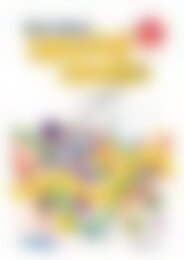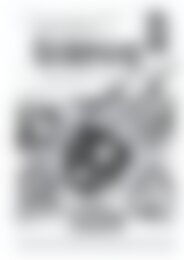RIC-6242 Primary Grammar and Word Study - Book C
You also want an ePaper? Increase the reach of your titles
YUMPU automatically turns print PDFs into web optimized ePapers that Google loves.
Parts of speech<br />
Adjectives<br />
Focus<br />
Common adjectives<br />
Definition<br />
• An adjective is a describing word. It adds meaning<br />
to or changes the meaning of a noun or a pronoun.<br />
Example:<br />
These are comfortable shoes.<br />
(describes the noun, ‘shoes’)<br />
The car is shiny.<br />
(describes the noun, ‘car’)<br />
Note: The adjective does not always come before the<br />
noun.<br />
She is kind.<br />
(describes the pronoun, ‘she’)<br />
Explanation<br />
The use of suitable adjectives not only makes our<br />
written or spoken language more interesting, it gives<br />
the reader or listener a clearer underst<strong>and</strong>ing.<br />
Worksheet information<br />
• Discuss what a describing word or adjective is with<br />
the students. Ask them to think of a suitable word<br />
to describe the colour/type of their eyes, hair or an<br />
article of clothing they are wearing.<br />
Example:<br />
I have brown eyes.<br />
I have straight hair.<br />
I’m wearing white socks.<br />
Encourage them to use the adjective in context in a<br />
sentence.<br />
• Read the story ‘A visit from Planet Pogo’ with the<br />
students, helping them to identify the adjectives.<br />
If students first identify the noun, they can ask<br />
questions such as ‘What kind?’ in front of it to find<br />
the adjective; for example, in the first sentence, the<br />
word ‘noise’ is a noun in this context.<br />
Ask: ‘What kind of noise?’ <strong>and</strong> the answer is ‘A loud<br />
noise’ (i.e. ‘loud’ is the adjective). Point out that not<br />
all nouns will have a word that describes them;<br />
e.g. ‘homework’ in line 1. Note: The first word in<br />
sentence 4, ‘It’, is a pronoun representing the noun<br />
‘spaceship’ <strong>and</strong> the adjective that describes it is<br />
‘silver’.<br />
• Students answer the questions, highlighting or<br />
circling the adjectives in the story. This activity is<br />
intended to reinforce the importance of choosing<br />
suitable adjectives to make a story more interesting<br />
<strong>and</strong> to give the reader/listener a clearer picture.<br />
• In Activity 2, students can choose more than one<br />
adjective to describe their alien. Share student<br />
responses with the class when the activities are<br />
completed.<br />
Ideas for further practice<br />
• Give pairs of students a paper bag (or similar) with<br />
an object inside. Students decide on four suitable<br />
adjectives to describe the object <strong>and</strong> write them in<br />
large letters on a sheet of paper. They hold up the<br />
words <strong>and</strong> other students try to guess what is in the<br />
bag. Further adjectives can be suggested if students<br />
are unable to guess.<br />
• Display an object from the classroom or a large<br />
picture that represents a noun such as a building<br />
or an animal. Students brainstorm to list suitable<br />
adjectives to describe it. Suggest more inappropriate<br />
examples <strong>and</strong> ask students why they are not<br />
suitable.<br />
Example:<br />
‘skinny’ would not describe an apple.<br />
©R.I.C. Publications<br />
Low Resolution Images<br />
Display Copy<br />
Answers<br />
1. (a) a loud noise<br />
(b) silver<br />
(c) a dust storm<br />
(d) a large bucket, old cloths <strong>and</strong> the green<br />
garden hose<br />
(e) a shiny, silver spaceship<br />
2.–3. Teacher check<br />
<strong>Primary</strong> grammar <strong>and</strong> word study 12<br />
www.ricpublications.com.au R.I.C. Publications ®<br />
ISBN 978-1-74126-766-2


















